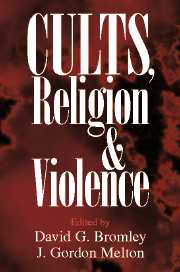Book contents
- Frontmatter
- Contents
- Acknowledgments
- Contributors
- Prologue
- 1 Violence and Religion in Perspective
- 2 Dramatic Denouements
- 3 Challenging Misconceptions about the New Religions–Violence Connection
- 4 Sources of Volatility in Religious Movements
- 5 Crises of Charismatic Legitimacy and Violent Behavior in New Religious Movements
- 6 Public Agency Involvement in Government–Religious Movement Confrontations
- 7 Watching for Violence: A Comparative Analysis of the Roles of Five Types of Cult-Watching Groups
- 8 Mass Suicide and the Branch Davidians
- 9 Occult Masters and the Temple of Doom: The Fiery End of the Solar Temple
- 10 Dramatic Confrontations: Aum Shinrikyô against the World
- 11 Making Sense of the Heaven's Gate Suicides
- 12 Lessons from the Past, Perspective for the Future
- Index
- References
9 - Occult Masters and the Temple of Doom: The Fiery End of the Solar Temple
Published online by Cambridge University Press: 09 July 2009
- Frontmatter
- Contents
- Acknowledgments
- Contributors
- Prologue
- 1 Violence and Religion in Perspective
- 2 Dramatic Denouements
- 3 Challenging Misconceptions about the New Religions–Violence Connection
- 4 Sources of Volatility in Religious Movements
- 5 Crises of Charismatic Legitimacy and Violent Behavior in New Religious Movements
- 6 Public Agency Involvement in Government–Religious Movement Confrontations
- 7 Watching for Violence: A Comparative Analysis of the Roles of Five Types of Cult-Watching Groups
- 8 Mass Suicide and the Branch Davidians
- 9 Occult Masters and the Temple of Doom: The Fiery End of the Solar Temple
- 10 Dramatic Confrontations: Aum Shinrikyô against the World
- 11 Making Sense of the Heaven's Gate Suicides
- 12 Lessons from the Past, Perspective for the Future
- Index
- References
Summary
On October 5, 1994, the Swiss police found the bodies of forty-eight members of the Order of the Solar Temple (OTS) on a farm in Cheiry and in three chalets in Granges-sur-Salvan. This tragic incident changed the entire picture of cult controversies in Western Europe, much more than events at Jonestown did in 1978 in the United States (Shupe, Bromley, and Breschel 1989). Its impact was reinforced by two subsequent OTS suicides, as well as by the Aum Shinrikyô case in Japan. Although active from the early 1970s, the European anticult movement had received minimal public support. After 1994, parliamentary commissions were appointed to investigate the danger of cults, and they produced, particularly throughout French-speaking Europe, official reports that essentially mirrored the views of the anticult movement. Although later reports were somewhat more moderate (Introvigne 1999a; Richardson and Introvigne 1999), documents produced in France (Assemblée Nationale 1996, 1999), Belgium (Chambre des Représentants de Belgique 1997), and the Canton of Geneva (Audit sur les dérives sectaires 1997) maintained a strict anticult position. It is significant that in addition to Quebec, the largest numbers of victims in the 1994 OTS tragedy were located in France (where an official “Mission to Fight Cults” was established in 1998), Belgium, and the Canton of Geneva.
In this chapter we discuss how a violent relationship between the OTS and the social order developed.
- Type
- Chapter
- Information
- Cults, Religion, and Violence , pp. 170 - 188Publisher: Cambridge University PressPrint publication year: 2002
References
- 5
- Cited by

